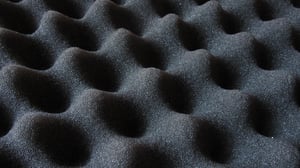There are so many options to choose from when looking for the right gasket; how do you know where to begin?
Maybe you settled on using a foam gasket, only to realize there are two different types: Open and closed cell foam gaskets.
The choice of material must suit your needs, so today, we're going to discuss closed foam gaskets in the context of what they can do for you.
What are Closed-Cell Foam Gaskets?
There are two main categories of cell foam gaskets: Open and closed. Although both types are helpful in their own ways, key differences dictate which gasket will fit your project better.
OPEN-CELL FOAM
Open-cell foam best resembles the surface of a sponge, containing many porous layers and air pockets.
Open-cell foam gaskets, often used for sound and shock absorption, are placed in recording studios, cases for electronics, medical packaging, and more.
Because of their absorption factor, open-cell foam gaskets are primarily intended for inside use. Their durability is limited, but the open-cell air pockets allow both compression and expansion. From the gaps in its appearance, you may have already guessed that an open-cell foam's air pockets enable it to remain lightweight and give it the ability to expand in tight spaces.
Open-cell foam's general shape and stiffness are less rigid than closed-cell foam, which flexes to match its surroundings.
Lastly, some variations of open-cell foam, such as polyurethane, are popular thanks to their low price. As a matter of fact, most open-cell foam is less expensive than closed-cell foam. If price is a large piece of the equation, you may want to try an open-cell foam gasket before ruling it out completely.
CLOSED-CELL FOAM
If open-cell foam best resembles a sponge, then closed-cell foam is like a sealed pot lid.
Unlike its counterpart, the closed-cell foam retains the gas bubbles formed during its creation. These trapped bubbles grant closed-cell foam gaskets many unique properties, such as the ability to repel water.
Unfortunately, the downside of closed-cell foam is its price, which tends to be significantly higher than open-cell foam. Either way, if you have a great need for the perfect material, the reward will outweigh the cost.
What are the Advantages of Using Closed-Cell Foam Gaskets?
Closed-cell foam has many advantages due to the airtight structure that renders it impervious to liquids and gases.
Its shape is more rigid, and although this prevents closed-cell foam from expanding to the same degree as open-cell foam, the stiffness will protect it from the elements.
Another benefit of the closed cell foam's density is its heat insulation, which makes closed cell foam gaskets perfect for HVAC systems or appliances. In addition, its heat-insulating properties can be used to insulate buildings, automobiles, or aircraft.
Closed-cell foam gaskets are durable, which can be valuable for large-scale or delicate projects involving extensive equipment or gas and oil that require safety-proofing.
Finally, closed-cell foam gaskets are often used outdoors. This is one of its key advantages over using open cell gaskets, as many jobs require a certain level of waterproofing or weatherability.
Here's a simple chart to illustrate the main differences between the two:
| OPEN-CELL | CLOSED-CELL | |
| Waterproof | X | |
| Soundproof | X | |
| Low cost | X | |
| Durable | X | |
| Heat Insulated | X | |
| Lightweight | X | |
| Outdoors | X | |
| Flexible | X |
If you're still unsure what type of cell foam gasket to use for your project or have questions about a related topic, let us know, and we'll do what we can to help you find what you're looking for.





